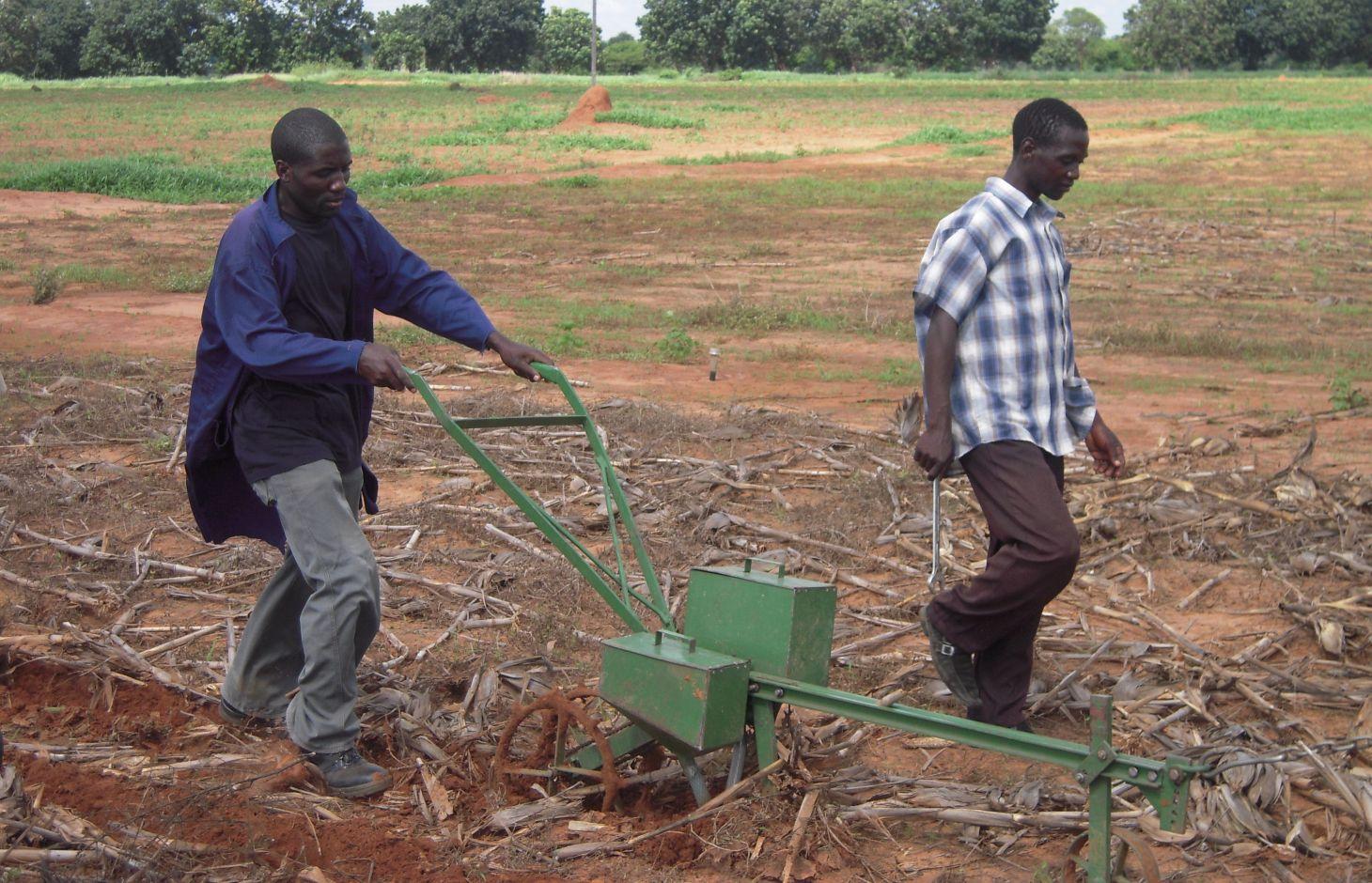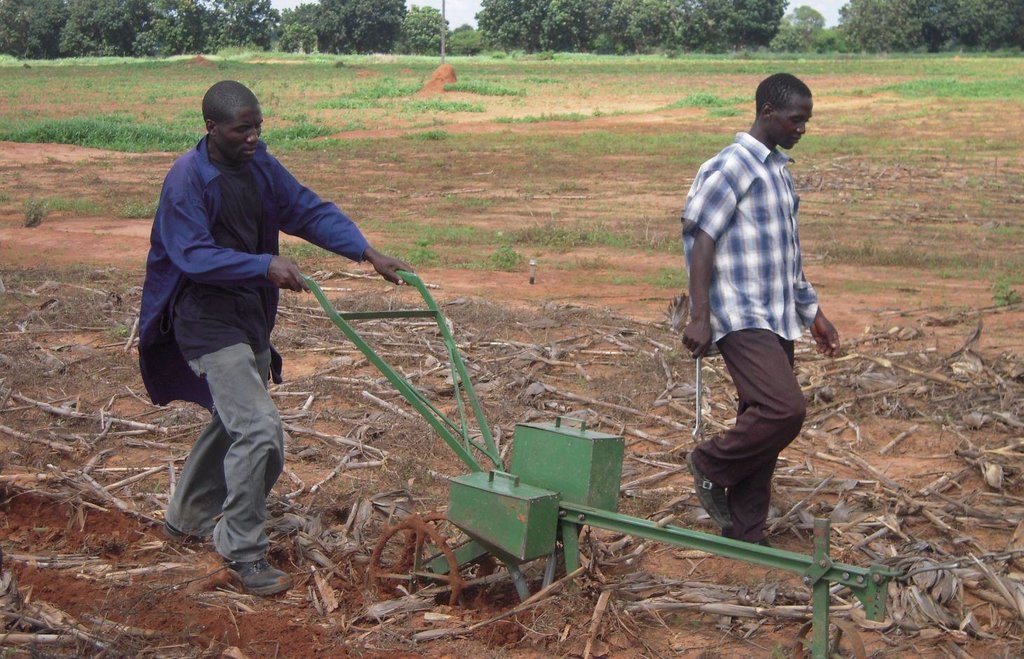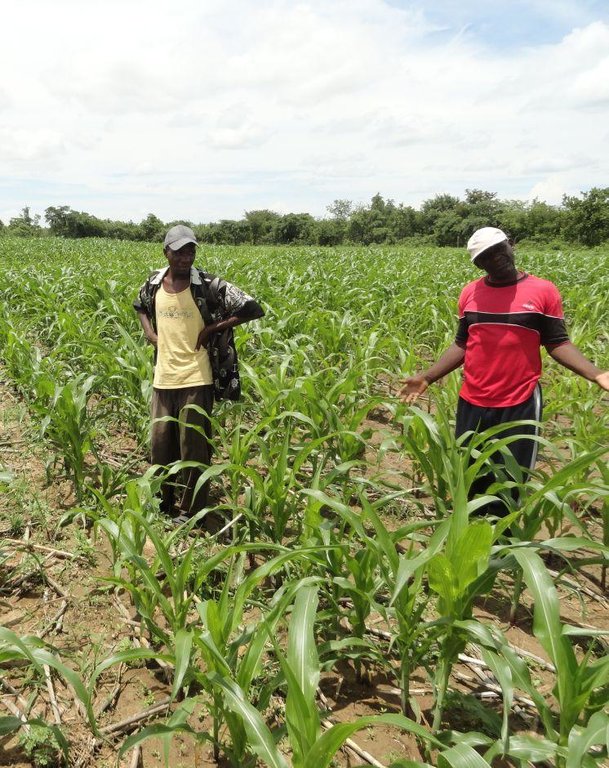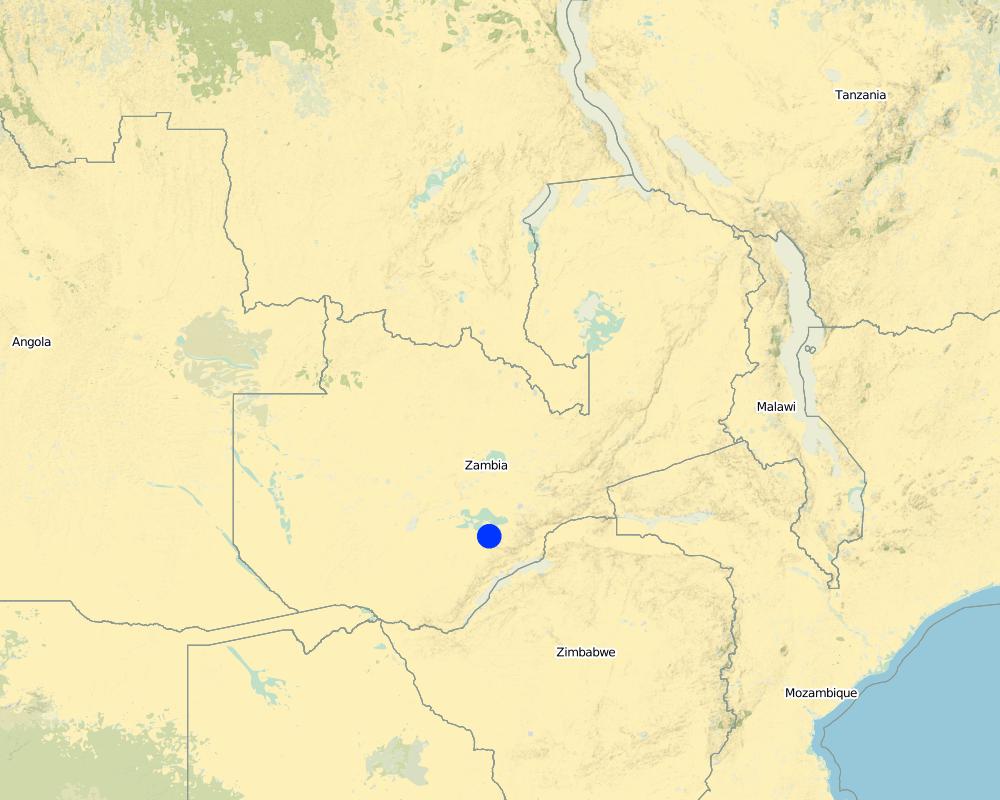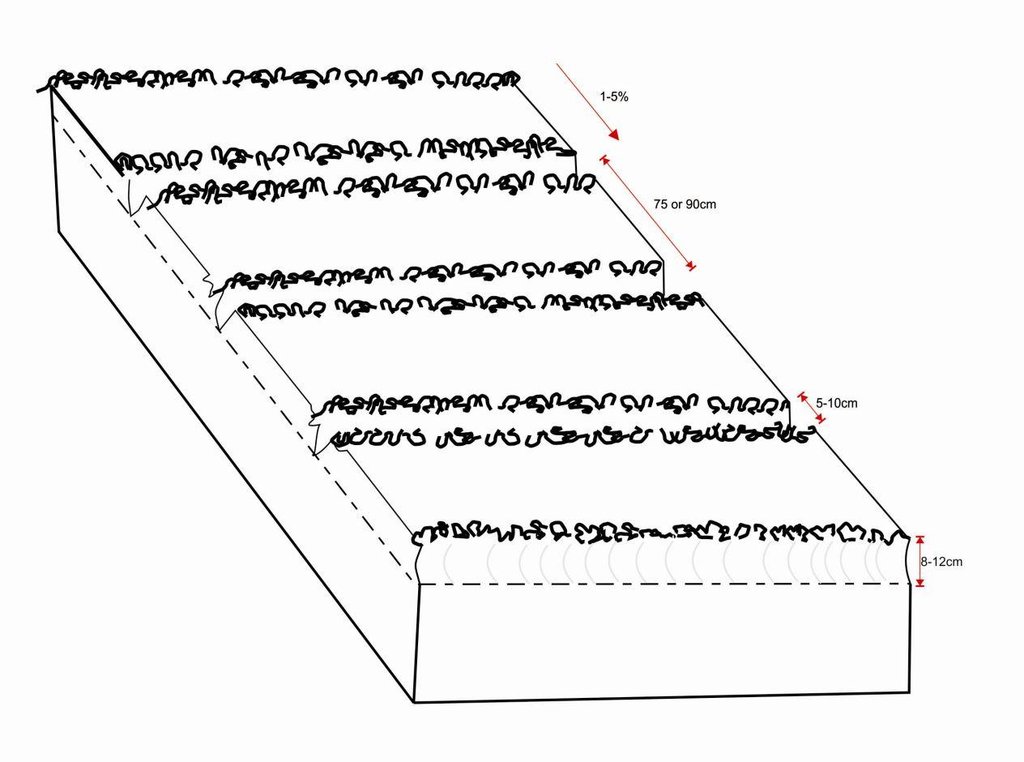Animal Draft Zero-Tillage [赞比亚]
- 创建:
- 更新:
- 编制者: Silenga Wamunyima
- 编辑者: –
- 审查者: Alexandra Gavilano, Fabian Ottiger
Direct Planting
technologies_1140 - 赞比亚
查看章节
全部展开 全部收起1. 一般信息
1.2 参与该技术评估和文件编制的资源人员和机构的联系方式
SLM专业人员:
Katoweji Alfred
Golden Valley Agricultural Research Trust
赞比亚
SLM专业人员:
Ndandula Sharon
Golden Valley Agricultural Research Trust
赞比亚
有助于对技术进行记录/评估的机构名称(如相关)
Golden Valley agricultural research trust (Golden Valley agricultural research trust) - 赞比亚1.3 关于使用通过WOCAT记录的数据的条件
编制者和关键资源人员接受有关使用通过WOCAT记录数据的条件。:
是
1.5 参考关于SLM方法(使用WOCAT记录的SLM方法)的调查问卷
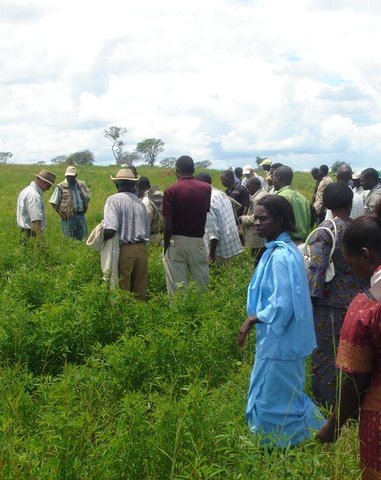
Participatory Research and Development [赞比亚]
This is a collaborative process between researchers and farmers for developing and adapting new technologies that focus on incorporating the perspectives and inputs from the farmers into the development process.
- 编制者: Arthur Chomba
2. SLM技术的说明
2.1 技术简介
技术定义:
Animal draft zero-till involves the use of an animal drawn mechanical planter to plant directly in untilled soil to minimize soil disturbance and leave a cover of crop residues to conserve the soil and water.
2.2 技术的详细说明
说明:
Zero-tillage takes advantage of the beneficial effects of biological processes to loosen the soil and to improve fertility. The organic matter from these processes aggregate the soil while the movement of soil organisms like worms and termites loosen the soil. This is called biological tillage and replaces mechanical tillage. The untilled soil surface covered by residues will require a planter specialized to plant in these conditions. In a sense, adopting zero-till does actually require a zero-till planter. The development of the strip-planter has made zero-till a viable option for animal draft farmers, which until now was not possible due to the unavailability or high cost of zero-till planters. The new planter is both cheap and easy to manufacture locally. The planter uses a narrow tine to open a planting furrow and seed/fertilizer is metered by vertically rotating plates. The planter is pulled by oxen and can plant rows of 75cm or 90cm rows with an intra-row which is determined by the seed plate used (3, 4, 5,…… seeds/m). The planting technology needs to be complemented with sound residue cover and weeding management practices.
Purpose of the Technology: The planter enables planting and fertilizing in untilled soil so that the soil residue cover and soil structure are preserved and can be used sustainably. The protective soil cover reduces evaporation and enhances infiltration while the improved soil structure and organic matter content increases soil water storage making zero tillage an important drought mitigating strategy. The immediate benefits of adopting zero-till are the possibility to plant a bigger area quickly and in time as well as the reduced soil erosion.
Establishment / maintenance activities and inputs: The first step in establishing zero-till is to assess the soil condition and levels of degradation. Where possible tests should be carried out but where not, the farmer needs to start on a small plot to check if there will be yield reduction from not tilling the soil. Where soils are severely degraded, an establishment phase should be embarked on where reduced tillage is practiced until the soil structure has recovered sufficiently to support crop growth without tillage. Liming acidic soils followed by a final ploughing will be required in the first year to correct the soil pH which otherwise will be difficult to correct once conservation tillage has been established. The organic matter levels need to be increased by increasing the amount of residues produced by the crop (i.e. the yields) and retaining these as soil cover. The next establishment activity is the purchase of the planter unit. Maintenance activities include planting and fertilizing in the same operation and weeding. Weeding will have to involve herbicide use to handle increased weed densities implying that spraying will become a major operation. In addition to the normal conventional inputs, herbicides will also become a major input and cost.
Natural / human environment: Zero-till has been applied in a wide range of bio-physical environments but mostly by the large scale farmers. The unavailability and high cost of specialized zero-till planter for small-scale farming has resulted in low adoption rates. The development of the Magoye Planter creates new opportunities for this practice. The farmer has to have sufficient knowledge to assess the soil condition and decide if is too degraded for zero-till or how long the transitional phase should be. Literacy is essential as the farmers will have to learn new approaches on weed control, pest control and crop rotations and adapt practices to suit his/her specific conditions.
2.3 技术照片
2.5 已应用该技术的、本评估所涵盖的国家/地区/地点
国家:
赞比亚
区域/州/省:
Zambia/Southern Province
有关地点的进一步说明:
Mazabuka/Magoye
注释:
Total area covered by the SLM Technology is 0.56 km2.
Zero-Till with the Magoye planter technology was introduced in 2011 and is only in its second season of use. Only four farmers have adopted the technology although it has not yet been officially launched and promoted.
Map
×2.6 实施日期
如果不知道确切的年份,请说明大概的日期:
- 不到10年前(最近)
2.7 技术介绍
详细说明该技术是如何引入的:
- 在实验/研究期间
注释(项目类型等):
Development of the Magoye planter began in 2008 in response to farmers’ feedback on the Magoye Ripper. Farmers started adopting the technology in 2011
3. SLM技术的分类
3.2 应用该技术的当前土地利用类型

农田
- 一年一作
年作 - 具体指明作物:
- 谷物类 - 玉米
- Annual cropping is the main source of livelihood.
每年的生长季节数:
- 1
具体说明:
Longest growing period in days: 135Longest growing period from month to month: mid Nov to end of March

牧场
粗放式放牧:
- 半游牧畜牧业
- Nearly half of the farmers own cattle but these are not sold regularly, only for school fees and ceremonies. Livestock is grazing on crop residues
注释:
Livestock density (if relevant):
1-10 LU /km2
Major land use problems (compiler’s opinion): Loss of soil structure and low soil fertility
Major land use problems (land users’ perception): Droughts and dry spell
3.4 供水
该技术所应用土地的供水:
- 雨养
3.6 包含该技术的可持续土地管理措施

农艺措施
- A1:植被和土壤覆盖层
- A2:有机质/土壤肥力
- A3:土壤表面处理
- A4:地表下处理
- A5:种子管理,改良品种
- A6:残株管理
- A7:其它
A3:区分耕作制度:
A 3.1:免耕
注释:
Specification of other agronomic measures: Zero till, Crop residue
Type of agronomic measures: early planting, mulching, manure / compost / residues, mineral (inorganic) fertilizers, soil conditioners (lime, gypsum), zero tillage / no-till
3.7 该技术强调的主要土地退化类型

土壤水蚀
- Wt:表土流失/地表侵蚀

化学性土壤退化
- Cn:肥力下降和有机质含量下降(非侵蚀所致)

物理性土壤退化
- Pk:熟化和结壳

生物性退化
- Bl:土壤寿命损失
注释:
Main causes of degradation: soil management (Overploughing, soil nutrient mining), crop management (annual, perennial, tree/shrub) (Monocropping), overgrazing (Overgrazing of crop residues), poverty / wealth (Charcoal burning, under application of fertilizer), inputs and infrastructure: (roads, markets, distribution of water points, other, …) (high cost of fertilizer)
Secondary causes of degradation: deforestation / removal of natural vegetation (incl. forest fires) (Charcoal burning), Heavy / extreme rainfall (intensity/amounts) (Overgrazing of crop residues), droughts, land tenure (Communal land overexploited), education, access to knowledge and support services (inadequate extension staff), governance / institutional (lack of credit facilities)
3.8 防止、减少或恢复土地退化
具体数量名该技术与土地退化有关的目标:
- 防止土地退化
- 减少土地退化
注释:
Secondary goals: rehabilitation / reclamation of denuded land
4. 技术规范、实施活动、投入和成本
4.1 该技术的技术图纸
技术规范(与技术图纸相关):
Planting lines are done at a depth of 8-12cm with inter row of 75 or 90cm. The width of the open furrow is 5-10cm wide. Planting rows are done across the slope to reduce runoff, these planting rows are done when the soil is moist during the rainy season and planting is done at the same time with land preparation. Farmers in Monze have combined ripping and zero till together. In the dry season they rip with the Magoye Ripper or GART Planter and later when the soil is moist use a zero till implement to plant.
Location: Magoye. Mazabuka/Southern Province/Zambia
Date: 2014-06-29
Technical knowledge required for field staff / advisors: high (This is a new technology and the extension staff must be able to help farmers troubleshoot and adapt the technology to local conditions.)
Technical knowledge required for land users: moderate (The farmers have to adopt new soil management practices, crop rotations and adapt the weeding approaches to complement the planting technology)
Main technical functions: improvement of surface structure (crusting, sealing), improvement of topsoil structure (compaction), increase of infiltration, increase / maintain water stored in soil
Secondary technical functions: control of raindrop splash, improvement of ground cover, improvement of subsoil structure (hardpan), increase in organic matter, increase in nutrient availability (supply, recycling,…), increase of groundwater level / recharge of groundwater, water harvesting / increase water supply, improvement of water quality, buffering / filtering water
Early planting
Material/ species: maize
Quantity/ density: 44,000 pla
Remarks: 25cm intra row by 75cm
Mulching
Material/ species: crop residues
Quantity/ density: 3ton/ha
Remarks: uniformly spread
Manure / compost / residues
Material/ species: crop residues
Quantity/ density: 3ton/ha
Remarks: uniformly spread
Mineral (inorganic) fertilizers
Material/ species: basal and top dressing
Quantity/ density: 400kg/ha
Remarks: spot application
Soil conditioners (lime, gypsum)
Material/ species: lime
Quantity/ density: 1ton/ha
Remarks: broadcast
作者:
Silenga Wamunyima, Box 670577, Mazabuka, Zambia
4.2 有关投入和成本计算的一般信息
其它/国家货币(具体说明):
Kwacha
如相关,注明美元与当地货币的汇率(例如1美元=79.9巴西雷亚尔):1美元=:
5.0
注明雇用劳工的每日平均工资成本:
2.40
4.3 技术建立活动
| 活动 | 时间(季度) | |
|---|---|---|
| 1. | Purchase a magoye planter | |
| 2. | Purchase a knapsack sprayer |
注释:
Life span of the magoye planter: 15 years
Life span of the knapsack sprayer: 5 years
4.4 技术建立所需要的费用和投入
| 对投入进行具体说明 | 单位 | 数量 | 单位成本 | 每项投入的总成本 | 土地使用者承担的成本% | |
|---|---|---|---|---|---|---|
| 设备 | Magoye Planter | piece | 1.0 | 500.0 | 500.0 | 100.0 |
| 设备 | Knapsack sprayer | piece | 1.0 | 80.0 | 80.0 | 100.0 |
| 技术建立所需总成本 | 580.0 | |||||
| 技术建立总成本,美元 | 116.0 | |||||
注释:
Duration of establishment phase: 2 month(s)
4.5 维护/经常性活动
| 活动 | 时间/频率 | |
|---|---|---|
| 1. | Slashing, spreading residues | May-June every year after harvest |
| 2. | Liming | Nov - Dec every 3years |
| 3. | Planting and fertilizing | Nov-Dec at onset of rain |
| 4. | Chemical weeding | 3 times per growing season |
| 5. | Harvesting | May-June |
4.6 维护/经常性活动所需要的费用和投入(每年)
| 对投入进行具体说明 | 单位 | 数量 | 单位成本 | 每项投入的总成本 | 土地使用者承担的成本% | |
|---|---|---|---|---|---|---|
| 劳动力 | Slashing, spreading residues | person days | 8.0 | 2.5 | 20.0 | 100.0 |
| 劳动力 | Liming | person days | 2.0 | 2.5 | 5.0 | 100.0 |
| 劳动力 | Chemical weeding | person days | 24.0 | 1.0 | 24.0 | 100.0 |
| 劳动力 | Harvesting | person days | 8.0 | 2.5 | 20.0 | 100.0 |
| 设备 | Animal traction for planting and fertilizing | ha | 1.0 | 40.0 | 40.0 | 100.0 |
| 植物材料 | Seeds | kg | 20.0 | 2.5 | 50.0 | 100.0 |
| 植物材料 | Fertilizer | kg | 400.0 | 0.8 | 320.0 | 100.0 |
| 植物材料 | Herbicides | l | 5.0 | 6.0 | 30.0 | 100.0 |
| 植物材料 | Lime | ton | 1.0 | 42.0 | 42.0 | 100.0 |
| 技术维护所需总成本 | 551.0 | |||||
| 技术维护总成本,美元 | 110.2 | |||||
注释:
Machinery/ tools: The Magoye planter
Calculation are for 1ha of maize under strip tillage based conservation tillage and costs are for the Zambia situation in Magoye as of August 2012.
4.7 影响成本的最重要因素
描述影响成本的最决定性因素:
The weed control method is the main determinate factor depending on whether the farmer uses hand hoe or herbicides. Weed densities are higher in unploughed fields increasing the labour requirements/costs by a factor of about 5 if hand weeding is used instead of herbicides. Another major cost is that of fertilizer which makes up about half the cost hence the total cost will vary significantly depending on fertilizer cost.
5. 自然和人文环境
5.1 气候
年降雨量
- < 250毫米
- 251-500毫米
- 501-750毫米
- 751-1,000毫米
- 1,001-1,500毫米
- 1,501-2,000毫米
- 2,001-3,000毫米
- 3,001-4,000毫米
- > 4,000毫米
农业气候带
- 半干旱
Thermal climate class: subtropics. 3 distinct seasons – summer, winter and one rainy season
5.2 地形
平均坡度:
- 水平(0-2%)
- 缓降(3-5%)
- 平缓(6-10%)
- 滚坡(11-15%)
- 崎岖(16-30%)
- 陡峭(31-60%)
- 非常陡峭(>60%)
地形:
- 高原/平原
- 山脊
- 山坡
- 山地斜坡
- 麓坡
- 谷底
垂直分布带:
- 0-100 m a.s.l.
- 101-500 m a.s.l.
- 501-1,000 m a.s.l.
- 1,001-1,500 m a.s.l.
- 1,501-2,000 m a.s.l.
- 2,001-2,500 m a.s.l.
- 2,501-3,000 m a.s.l.
- 3,001-4,000 m a.s.l.
- > 4,000 m a.s.l.
5.3 土壤
平均土层深度:
- 非常浅(0-20厘米)
- 浅(21-50厘米)
- 中等深度(51-80厘米)
- 深(81-120厘米)
- 非常深(> 120厘米)
土壤质地(表土):
- 中粒(壤土、粉土)
- 细粒/重质(粘土)
表土有机质:
- 低(<1%)
5.4 水资源可用性和质量
地下水位表:
> 50米
地表水的可用性:
中等
水质(未处理):
不良饮用水(需要处理)
5.6 应用该技术的土地使用者的特征
非农收入:
- 收入的10-50%
相对财富水平:
- 非常贫瘠
- 贫瘠
个人或集体:
- 个人/家庭
性别:
- 男人
说明土地使用者的其他有关特征:
Land users applying the Technology are mainly common / average land users
Difference in the involvement of women and men: The technology is applied mostly by men since most households are male headed and animal traction operation are reserved for men
Population density: 10-50 persons/km2
Annual population growth: 3% - 4%
8% of the land users are rich and own 15% of the land (own more than 10 cattle).
8% of the land users are average wealthy and own 15% of the land (own between 5 and 10 cattle).
16% of the land users are poor and own 20% of the land (own less than 5 cattle).
68% of the land users are poor and own 40% of the land (do not own cattle).
Off-farm income specification: sale of rainfed crops makes up about half of their income, the remainder coming from sale of livestock, petty trading, hiring out labour and remittances
Market orientation of production system: subsistence (self-supply), subsistence (self-supply), mixed (subsistence/ commercial
5.7 应用该技术的土地使用者使用的平均土地面积
- < 0.5 公顷
- 0.5-1 公顷
- 1-2 公顷
- 2-5公顷
- 5-15公顷
- 15-50公顷
- 50-100公顷
- 100-500公顷
- 500-1,000公顷
- 1,000-10,000公顷
- > 10,000公顷
这被认为是小规模、中规模还是大规模的(参照当地实际情况)?:
- 小规模的
注释:
Average area of land owned or leased by land users applying the Technology: 1-2 ha, 2-5 ha, 5-15 ha, 5-15 ha, 15-50 ha, 15-50 ha, 50-100 ha
5.8 土地所有权、土地使用权和水使用权
土地所有权:
- 个人,未命名
土地使用权:
- 自由进入(无组织)
- 个人
- Land is apportioned by traditional leaders
用水权:
- 自由进入(无组织)
- Land is apportioned by traditional leaders
5.9 进入服务和基础设施的通道
健康:
- 贫瘠
- 适度的
- 好
教育:
- 贫瘠
- 适度的
- 好
技术援助:
- 贫瘠
- 适度的
- 好
就业(例如非农):
- 贫瘠
- 适度的
- 好
市场:
- 贫瘠
- 适度的
- 好
能源:
- 贫瘠
- 适度的
- 好
道路和交通:
- 贫瘠
- 适度的
- 好
饮用水和卫生设施:
- 贫瘠
- 适度的
- 好
金融服务:
- 贫瘠
- 适度的
- 好
6. 影响和结论性说明
6.1 该技术的现场影响
社会经济效应
生产
作物生产
饲料生产
生产故障风险
生产区域
SLM之前的数量:
2-3ha
SLM之后的数量:
>10
收入和成本
农业收入
收入来源的多样性
工作量
社会文化影响
娱乐机会
生态影响
水循环/径流
水质
水的回收/收集
地表径流
蒸发
土壤
土壤水分
土壤覆盖层
土壤流失
土壤结壳/密封
土壤压实
养分循环/补给
盐度
土壤有机物/地下C
生物多样性:植被、动物
生物量/地上C
减少气候和灾害风险
碳和温室气体的排放
6.2 该技术的场外影响已经显现
水资源可用性
下游洪水
地下水/河流污染
对邻近农田的破坏
6.3 技术对渐变气候以及与气候相关的极端情况/灾害的暴露和敏感性(土地使用者认为的极端情况/灾害)
渐变气候
渐变气候
| 季节 | 增加或减少 | 该技术是如何应对的? | |
|---|---|---|---|
| 年温度 | 增加 | 未知 |
气候有关的极端情况(灾害)
气象灾害
| 该技术是如何应对的? | |
|---|---|
| 局地暴雨 | 好 |
| 局地风暴 | 未知 |
气候灾害
| 该技术是如何应对的? | |
|---|---|
| 干旱 | 好 |
水文灾害
| 该技术是如何应对的? | |
|---|---|
| 比较和缓的(河道)洪水 | 不好 |
其他气候相关的后果
其他气候相关的后果
| 该技术是如何应对的? | |
|---|---|
| 缩短生长期 | 好 |
6.4 成本效益分析
技术收益与技术建立成本相比如何(从土地使用者的角度看)?
短期回报:
积极
长期回报:
非常积极
技术收益与技术维护成本/经常性成本相比如何(从土地使用者的角度看)?
短期回报:
积极
长期回报:
非常积极
注释:
Timely and quicker planting enables larger areas to be planted and with less labour in the short term. Improved soil structure and soil fertility leads to higher yields and better resilience to droughts in the long term
6.5 技术采用
- 单例/实验
在所有采用这项技术的人当中,有多少人是自发的,即未获得任何物质奖励/付款?:
- 0-10%
注释:
4 land user families have adopted the Technology without any external material support
Comments on spontaneous adoption: The Magoye planter has not yet been officially launched or promoted and the farmers currently using the technology heard of it by word of mouth and insisted on purchasing
There is a strong trend towards spontaneous adoption of the Technology
There has been numerous inquiries to purchase the Magoye planter even before it can be promoted
6.7 该技术的优点/长处/机会
| 土地使用者眼中的长处/优势/机会 |
|---|
|
Enables early planting How can they be sustained / enhanced? Plant in with the first rain |
|
Quicker planting enables the planting of larger areas How can they be sustained / enhanced? Plant the seed and fertilize in one operation |
|
reduced workload How can they be sustained / enhanced? Encourage minimum tillage |
| 编制者或其他关键资源人员认为的长处/优势/机会 |
|---|
|
Enables early planting How can they be sustained / enhanced? Plant in November with the first heavy rain |
|
Quicker planting enables the planting of larger areas How can they be sustained / enhanced? Use herbicides because without them, the capacity to weed will limit the production capacity |
|
Preserves soil cover and reduces soil disturbance How can they be sustained / enhanced? Training in residue management and zero till |
6.8 技术的弱点/缺点/风险及其克服方法
| 土地使用者认为的弱点/缺点/风险 | 如何克服它们? |
|---|---|
| The purchase price of the Magoye planter is quite high | Subsidize the implement |
| Excessive weeds and lack of information on herbicide use | More training on herbicide use |
| 编制者或其他关键资源人员认为的弱点/缺点/风险 | 如何克服它们? |
|---|---|
| The purchase price for the planter is on the higher side making it affordable only to the larger small-scale farmers | the price is likely to go down when the planter is mass produced |
| difficult to control weeds in the absence of herbicides | use herbicides |
7. 参考和链接
7.1 信息的方法/来源
7.2 参考可用出版物
标题、作者、年份、ISBN:
Social-economic analysis of conservation agriculture in southern Africa, FAO, 2011
可以从哪里获得?成本如何?
FAO
标题、作者、年份、ISBN:
Conservation farming in Zambia, Steven Haggblade, Gelson Tembo, October 2003
可以从哪里获得?成本如何?
Indaba project, Michigan state university
标题、作者、年份、ISBN:
Conservation farming in Zambia, Conservation farming unit (CFU), 2011
可以从哪里获得?成本如何?
cfu@zamnet.zm
链接和模块
全部展开 全部收起链接

Participatory Research and Development [赞比亚]
This is a collaborative process between researchers and farmers for developing and adapting new technologies that focus on incorporating the perspectives and inputs from the farmers into the development process.
- 编制者: Arthur Chomba
模块
无模块


